CONSTELLATION GUIDE
Last updated: 3 June 2001
CONSTELLATION GUIDE |
"GO TO"....LIBRA
(and some strokes for Lupus, the Wolf)
....merely a question of balance.
From: sherrodc@ipa.net (Clay Sherrod)
This is the fifteenth Constellation Guide, "GO TO LIBRA" of the series "GO TO GUIDES for the ETX and LX 90 Telescope Users". In case you have never looked into this rather vague constellation - the "7th Sign of the Zodiac" - you perhaps have no idea how difficult it is to make this interesting as a GO TO constellation study! Nonetheless, there ARE some interesting attributes of this obscure area of the sky. Included in this featured "GO TO" TOUR is the more southerly constellation LUPUS, the Celestial Wolf.....somewhat of a newcomer to the 88 constellations recognized by the International Astronomical Union (IAU).
Since Lupus is so far south of the celestial equator, it is a difficult constellation for observers in the northern hemsphere to concentrate on, save those in southern states of the United States and southern Europe. Nonetheless, this canine of a constellation deserves some attention as there are some interesting objects within grasp of our telescopes.
Libra, like Lupus is ALSO somewhat of a "newcomer" as far as named constellations go. It is ONLY because of its location within the ZODIAC - the twelve star patterns near the celestial equator through which all the planets, sun and moon appear to pass as we observe from Earth - that Libra is denoted as a "stand-alone" constellation at all!
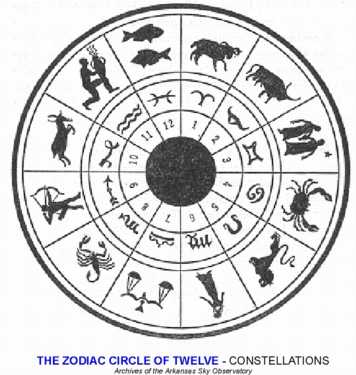
The only four brighter stars of Libra - alpha, beta, gamma and iota - for a small square shape in the sky, but at one time the star group was actually part of SCORPIUS (http://www.weasner.com/etx/ref_guides/scorpius.html ), forming the "claws" or front pinchers of this venomous arachnid. It was the Egyptian priest-astronomers who first isolated the larger Scorpius into two separate constellations, although the reasoning is NOT all that clear for doing so.
There is speculation however as to the importance of this dull star group to these early people. It is theorized from much later hieroglypics from those of the great Pyramids that the pattern of obscure stars symbolized the EQUALITY of day and night.....exactly what happened at the spring and autumn equinox as the SUN entered this now-constellation some 2000 years ago. Presently, through precession of the Earth, the autumnal equinox - where the sun crosses the celestial equator at the beginning of autumn has "migrated" from Libra westward into Virgo (see http://www.weasner.com/etx/ref_guides/virgo.html ).
In the year 2000 and beyond for our lifetimes, the sun goes through Libra in November, passing bright Antares (in Scorpius) in the first week in December as it approaches Winter Solstice.
Now - a lesson in changes of history, and how most things really make sense if you know all the facts. Remember the ZODIAC? The name is from the Latin as the "zone of animals," signifying the nature of the constellations that primarily the sun passed through to early stargazers. The ONLY constellation of the Zodiac that is NOT an "animal" is......LIBRA. Why? Because Libra has not always "been there..." It originally was part of the 6th "sign" of the Zodiac: Scorpius.
This explanation as to the Egyptian importance of making this a separated entity in the sky ALSO explains very well why we envision a "scale" or "balance" of all things for this constellation. It seems somewhat out of place, doesn't it? Well, when you consider the importance of the fall equinox and the position of this constellation 2000 years ago as winter months approached....perhaps it quickly explains both the significance and labeling of this inconspicuous star pattern.
Although now a stand-alone ("isolated" is a good word for Libra) constellation of its own, Libra still has strong ties to its original affiliation with Scorpius through the original star names given to its brightest stars by the earliest Arabian skywatchers. We often overlook the beauty and creativity of their insight into the wonderful star names that we still preserve (thankfully) today.
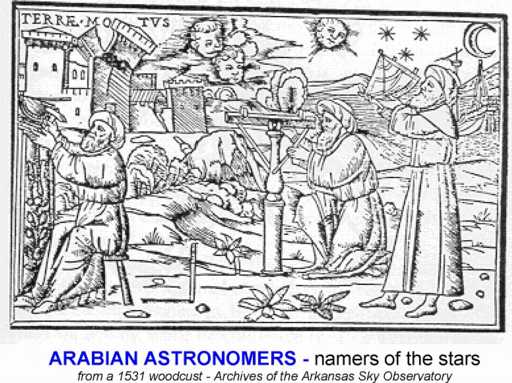
The principal stars (although very faint to the naked eye) all have some association with CLAWS of the dreaded Scorpion! "ZUBEN ....." referred to the appendages of this creature to the Arabian astronomers/astrologers. Thus, we have the brightest (alpha) star named ZUBEN EL GENUBI ("the Southern Claw"), beta being ZUBEN ESCHAMALI ("the Northern Claw"), ZUBEN EL AKRAB (gamma), ZUBEN EL AKRIBI (delta), and ZUBEN HAKRIABI (upsilon), as shown in the chart below.
Aren't these simply wonderful star names?
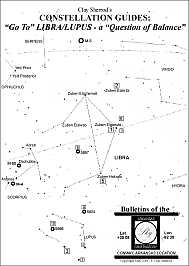
As with all "GO TO" TOUR guide star charts, please click on this accompanying chart to open; you can save this to file, resize to paper size and print for a nice usable desk reference or good field chart as you proceed through the Libra "GOT TO" TOUR.
After the wonderfully rich TOURS of Coma Berenices (http://www.weasner.com/etx/ref_guides/coma-berenices.html and Virgo (http://www.weasner.com/etx/ref_guides/virgo.html ), this one might seem pale by comparison....indeed after a quick flurry of nearly 80 galaxies combined in the previous two guides, we do not discuss even ONE galaxy for your Libra or Lupus TOUR!
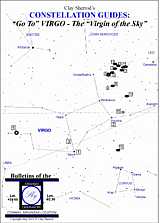
Note from the sky chart included here that the CELESTIAL EQUATOR passes just NORTH of Libra, and thus all angular measures (declinations) are south of the celestial equator and negative ("-"); hence you will see references in this "GO TO" GUIDE to "(-)" declinations for celestial objects in both Libra and Lupus.
Also note that the ECLIPTIC (the band in which all the planets, sun and moon appear to move relative to Earth, on which the "Zodiac", above is centered) passes from southeast to northwest through Libra. Thus, there are on some occassions (not anytime soon for the early decade of the 21st century!) bright planets that linger from time to time in this star-poor region of sky.
----------------------------------
As with every "GO TO" TOUR guide, ach GO TO object in Libra and Lupus is discussed for your telescope regarding the type of conditions necessary for you to view it optimally for discern the very faintest details.........magnifications and aperture necessary for most objects, and much, much more. This is YOUR complete GUIDE to get you on your way to exploring the best (and few!) objects in these two constellations. The following listing of "BEST" objects contains the finest or most interesting from my own observing experience and preference.
Use the attached star chart and the following Guide as an excellent reference for your next star party itinerary, or a beginning for further study into the thousands of objects visible in this part of the sky. Truly these extensive Constellation Study Guides will most definitely put your AutoStar to work for you in the most efficient and enjoyable way possible! As a matter of fact, MANY AutoStar users are now programming their own "Tours" based on these guides, using each constellation as a separate GO TO Tour for the AutoStar library that can be added in or deleted through the main edit screen on your PC or MAC computer.
We hope you enjoy these comprehensive GUIDES to touring the constellations via your AutoStar and its computer-driven telescope. Each new installment is complete with diagrams, charts and illustrations that you will find nowhere else. Please let us hear YOUR feedback and your observations of each and every constellation after YOU have toured its vast reaches of our skies!
-----------------------------------
YOUR LIBRA / LUPUS CONCISE DIRECTORY OF INTERESTING OBJECTS -
Certainly there is slim pickings for real "show-stopper" celestial objects in both Libra and Lupus. Nonetheless, there are many objects that make our visit rewarding and worthwhile!
I have chosen the finest (or most interesting) 11 objects in this LIBRA / LUPUS "GO TO" TOUR; as with all GUIDES, all objects listed below will be visible in most telescopes (some naked eye) from the ETX 60 through the LX 90; of course larger apertures may "show" an object a bit closer and "better," but frequently a wide field and low power view is more desirable than aperture for FINDING the objects initially. Indeed, I strongly encourage you first FIND the target object, or its approximate location through your GO TO function with your lowest power and then - once IDENTIFIED positively - move up slowly in steps with magnification if necessary. Remember, not all objects "like" magnification.
The rule for determining "optimum magnification" is that: 1) too low power results in sky background glow detracting or dimishing the contrast against the deep sky object; 2) too high magnification darkens BOTH the sky background AND the object; 3) medium magnification can be achieved at which you have MAXIMUM contrast between the object and its darkened background sky. I have found through three decades of direct observing that about 15x per inch aperture (36x for the ETX 60/70; 55x for the ETX 90; 75x for the ETX 125; and, 125x for the LX 90).for deep sky observing is PERFECT for most objects. That being said, always remember that DOUBLE or multiple stars require whatever power you can crank out....the seeing conditions are the limiting factor here.
For my complete and comprehensive discussion regarding seeing conditions and sky transparency, see: http://www.weasner.com/etx/buyer-newuser-tips/seeing.html .
With all deep sky objects, avoid attempting to observe when the moon is in the sky, even a very thin crescent, as its brightness in the sky will overshadow the very dim contrast afforded by even the brightest deep sky object; if you see the object at all against moonlight, you will NOT see the subtle outlying areas or the full detail of what is presented.
The convenient sky placement of Libra during spring and early summer lends itself well to very good and long-period observing for ETX and LX 90 users both north and south of the equator. When rising about dark in the east (mid-spring) it will remain in the sky throughout the night, transiting the meridian just before midnight during that season. All deep sky objects and difficult double stars are ALWAYS best observed when they are located nearly overhead (or as high in the sky as possible), thus requiring the observer to look through the thinnest portion of the Earth's "lens" of atmosphere and haze.
As with all of the "GO TO" TOUR constellation lists, I recommend a good star atlas and/or chart which will list all the finest objects, constellation-by-constellation. One very handy reference guide is the PETERSON FIELD GUIDE TO THE STARS AND PLANETS, which features complete lists with declinations, right ascensions, magnitudes, and all pertinent information for you to expand your observing horizons beyond this brief GUIDE.
Note that your AutoStar will NOT have every object listed on every constellation GO TO tour....this is intentional. You can access some of the most interesting objects of the sky directly from their coordinates. It is quite simple as you merely enter these coordinates as follows in the 10-step process:
1) Press the "MODE" key and hold down for 3 seconds and release;
2) Displayed will be the current Right Ascension and Declination of the center of field of view of where your telescope is presently pointed (assuming that you have properly aligned from "home position");
3) [NOTE: if you have the Meade electric focuser attached to any of the ETX or LX telescopes, holding down the "MODE" key will bring up the "Focus" command first....merely scroll (lower right scroll key) down one step to access the RA and DEC to enter your desired coordinates]
4) Press the "GO TO" button on AutoStar;
5) This will change the display and you will note the cursor blinking over the first digit of RIGHT ASCENSION (R.A.); merely use the number keys and dial in the R.A. of the object you are searching for;
6) When done, press "Enter;"
7) This moves the blinking cursor over the "DEC" coordinates;
8) [NOTE: the declination, unlike R.A., can be either positive or negative and you will see the "+" or "-" sign displayed depending on where your telescope is aimed at that time; if it is NOT the desired setting (plus or minus), merely use your arrow key to move the blinking cursor OVER the "+" or "-" sign and change by using either of your lower corner SCROLL KEYS;
9) Proceed to enter the DEC using number keys;
10) Press either "Enter" or "Go To" when finished and the telescope begins slewing to your desired object!!
The constellation tour Star Chart above (click on and save to a file on your PC; then open it and re-size to fit the page and print for a very handy at-the-scope star chart) will get you started on your journey for this constellation.
Following is the concise object list for your "GO TO" TOUR of LIBRA and LUPUS; you may wish to find the majority of the objects from the AutoStar Library (for example, you can easily go to NGC 5897 if you pull up "Object/Deep Sky/NGC/..then type in '5897'...." and then press "Enter", followed by "GO TO" to access this remote globular cluster (Messier 13 it is NOT!). On the other hand, if you want to experiment and become a "better AutoStar user" try entering the exact R.A. and DEC coordinates of that object as described above after holding down the MODE key. You will find the accuracy of entered GO TO's to be somewhat less than those stored in AutoStar, but the capability of acquiring unlisted objects is fantastic!
OBJECT 1:
brighter star - ZUBEN EL GENUBI (alpha Librae) - R.A. 14h 48' / DEC (-)15 50 - Magnitude: 2.8
OBJECT 2:
naked eye variable - ZUBEN EL AKRIBI (delta Librae) - R.A. 14H 58' / DEC (-) 08 19 - Mag: 4.7 to 5.9
OBJECT 3:
nice double star - eta Lupi - R.A. 15h 19' / DEC (-) 44 31 - Mags 3.9 & 6.0 great ETX 90 test, tough!
OBJECT 4: (Lupus)
supernova remnant! - "Nova 1006" - R.A. 15h 00' / DEC (-) 41 42 - First EVER recorded! Visit its "grave"
OBJECT 5: (Libra)
nice double - ZUBEN HKRABI - upsilon Librae - R.A. 15h 34' / DEC (-) 27 58 - Mags: 4 & 11.5, nice test!
OBJECT 6: (Libra)
nice double star - mu Librae - R.A. 14h 47' / DEC (-) 13 57 - Magnitudes: 5.5 & 6.5, great for ETX 90 +
OBJECT 7: (Lupus)
southern double - pi Lupi - R.A. 15h 02' / DEC (-) 46 51 - Magnitudes: 4.7 & 4.8 - great star for ETX 90 +
OBJECT 8: (Libra)
globular cluster - ngc5897 - R.A. 15h 14' / DEC (-) 20 50 - Magnitude: 10.8, very loose, nice cluster!
OBJECT 9: (Lupus)
globular cluster - ngc5824 - R.A. 15h 01' / DEC (-) 32 53 - Magnitude: 9.5, bright and very small - nice!
OBJECT 10: (Lupus)
globular cluster - ngc5986 - R.A. 15h 43' / DEC (-) 37 37 - Magnitude: 8, very bright and resolvable!
OBJECTS 11: (Libra)
nice variable stars - V Librae (long period) / UW Librae (semi regular) - R.A. 14h 38' / DEC (-) 17 27
---------------------------------
A VISUAL GUIDE TO OUR DEEP SKY OBJECTS IN LIBRA
Object 1 - Our "Starting" Brighter Star - "ZUBEN EL GENUBI" (alpha Librae) - Also a nice double!
Our starting point for every "GO TO" TOUR is always (or usually!) the brightest star of the constellation or region and Libra holds no exception. This is by far the DIMMEST bright star we have used as our "starting target" for any constellation "GO TO" TOUR, being only magnitude 2.8, with no other conspicuously bright stars anywhere close.....until looking far to the southeast at rising Scorpius and all of its bright and colorful Milky Way stars.
Denoting the "Southern Claw" of what used to be Scorpius (see above), Zuben El Genubi is a close star, only about 65 light years away....it is a highly evolved star, with spectrum indicators of later evolutionary stages. In the ETX 60 and 70, look about only 4' arc from Alpha and find star "8 Librae", a true double companion to Zuben El Genubi at magnitude 5.2. This is one of the nicest pairs of all for the wide fields of view of these low power refractors, and is a very pleasing sight in all telescopes larger using very low magnifications.
Object 2 - "Zuben El Akrisi" - (delta Librae) - A Very Good Naked Eye / ETX 60-70 Variable Star
Remember the star "Algol" listed on your AutoStar? You can dial in under EVENTS and find out the exact closest time of minimum brightness of this ECLIPSING BINARY star.
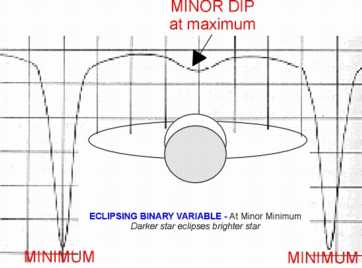
Algol-type variable stars are very simple; they have two stars (one brighter than the other) which orbit one-another and - from our line of sight - occassionaly one ECLIPSES the other, or "covers it up." From our distance, we see the brightness of TWO very close stars normally; however, when the second (darker) star orbits in front of the first star, we see ONLY the brightness of the darker star in the foreground. In the diagram above, you can clearly see the nature of the eclipsing binary-type stars. If it is the brighter star that is in front, the minimum is NOT as dim as just stated.
Delta Librae - ZUBEN EL AKRISI - is just such a star, with the combined brightness of 4.7 eclipsed every 2.32735 days into the brightness of ONLY star "B", or about 6.0. Although this cycle can be seen clearly with the naked eye on very dark nights all the way through minimun (mid-eclipse by the darker star), this phenomenon is best seen with the ETX 60 and 70 with their wonderfully wide fields of view; binoculars also afford an excellent way of monitoring the cycle of these two stars. An AAVSO star chart is NOT available for this bright and rapidly-changing variable, but you can use the brightness of the major Libra stars as guides as shown in my special bright star magnitude chart for Libra below.
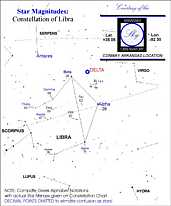
alpha - 2.75 upsilon - 3.78 48 librae - 4.85 beta - 2.74 mu - 6.10 18 librae - 5.95 gamma - 4.02 iota - 4.66 5 librae - 6.50 theta - 4.34 sigma - 3.31 47 librae - 6.00
Object 3 - A Beautiful Double Star - Eta Lupi - YES, you can see this one from most of the United States!
Here is a great southern double star that can be located even in the northern hemisphere observing latitudes. Eta Lupi is a beautiful and bright yellow pair of stars, both of equal 5.5 magnitude brightness and only 10.5" arc separation. Thus, these can be clearly resolved with even the ETX 60 and 70 at medium power and the stars make a gorgeous pair in the larger telescopes at low and medium-low powers. The stars are oriented in a NE-SW fashion and orbit one-another in a period of 51 years. At southern declination -33 degrees, this star should be accessible for observers south of the Mason-Dixon line in the United States and from the southern latitudes of Europe.
Object 4 - A Place Where a Star ISN'T! - The Location of Nova 1006 in Lupus
Turn your telescope via the AutoStar to this spot and you will be peering at a celestial graveyard, a place that dominated the nighttime sky in the year 1006, the event being the very first historically recorded supernova on record. Today, nothing brighter than magnitude 17 appears at this exact location (14h 59.6m / -41 degrees 42m), but in its heyday, Nova Lupi 1006 was a terrifying and brilliant sight. The finder chart below from my Observatory denotes the exact position near Beta Lupi where the Nova was thought to have been centered.
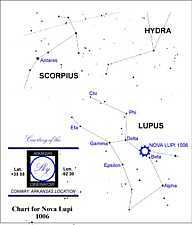
The star was recorded in Medieval Europe, China, Arabia, Egypt and Japn in that year in the spring of 1006 as an object that might have been FOUR TIMES BRIGHTER than the brilliant planet Venus and almost half as bright as the moon! The Egyptians recorded the object (outburst?) as a "comet" or "Nayzak," but there is no mention of the characteristic tail. Arabian astronomers noted that the "rays" of this huge star appeared to illuminate the ground of Earth much like those from the light of the moon! Many of the same sages of the region noted that the appearance of this sudden and bright "new star" occured, not coincidentally in their minds, with "...strong winds, bursts of lightening, and shattering thunder with no rain." Chinese astronomer/priests recorded very accurately the date of first appearance as May 1, 1006. It was seen incredibly as very bright all the way until it disappeared below the western horizon that following September! No trace of the star - now totally converted to energy save a very small portion of mass - remains as with some supernovae....no diffuse nebula, but perhaps only a tiny ring of gas that is seen surrounding a faint 17th magnitude star near that position. However, Radio Source #1459-41 only 1.5 degree NE of Beta Lupi is likely the remaining energy of that primordial explosion.
Object 5 - Another Good Double Star - "Zuben Hakrabi" - (upsilon Librae) - Your ETX 90 "supertest"
This is a GREAT star to try on either the ETX 90 or ETX 125.....it might give some LX 90 users a bit of frustration as well! This is a wonderful pair with strongly contrasting brightnesses, but both are accessible in the ETX 90 and above scopes. The primary star is a bright magnitude 4, while the orbiting secondary star is a faint 11.5! Thus, it is right at the limit of the 3.5 inch scope. Look for the faint star nearly due SOUTH of the brighter one, only 3.3" arc separation between the two, also attainable with the -90 and larger scopes. However, the glare from the brighter star will make the target all the more difficult to see. Both stars are very RED stars, and the color of the brighter one should be distinctive in the ETX 125 and LX 90. The secondary star will not be visible in the ETX 60 or 70 scopes.
Object 6 - A Great Double Star - Mu Librae - ETX 125 and LX 90 only please! Tough for the ETX 125!
Here are two totally different stars as a pair when compared to upsilon above. This is a pair of stars, magnitudes 5.5 and 6.5 that are VERY close (only 1.8" arc) together and should make a very tough test for the ETX 125, even though that spacing is well within its limit. Theoretically, the ETX 90 (with a 1.3" arc Dawe's limit) SHOULD be able to separate these two stars....good luck! Look for the slightly fainter star "just" southwest of the brighter one, but almost touching. Once you have found the correct star in low magnification, begin moving up in steps higher and higher until you can begin to "elongate" the image. It might take as much as 150x in the LX 90 and 200x in the ETX 125 and 90 scopes.
Object 7 - A Double for "Southern Folk" - Pi Lupi
Here is another one like the one just preceding. Equal magnitude stars (5th and 5th) and separated by ONLY 1.4" arc, only 0.1" wider than the theoretical limit of the ETX 90.....so how good is YOUR telescope? I suspect that this will be VERY tough even for the ETX 125. It is fairly easy in the LX 90, however, and I have "elongated' it in my 5" several times. At the very low declination of minus 46 degrees, this is an object only accessible to those lucky observers south of latitude 25 degrees north.
Object 8 - NGC 5897- A "Real" Deep Sky Object - Most Unusual Sparse Globular Cluster
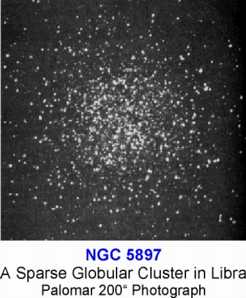
Don't expect a Messier 13 out of this globular, but it is an interesting - but difficult - object. It is likely to be missed in the ETX 90 and smaller telescopes, since this is a very big (8.1' arc - 1/3 the size of the moon's disk) and very dim (10th magnitude) globular. Hence, its brightness is spread out over a very large area of sky. The photo above, taken with the 200" Palomar telescope, will give you some idea of how faint the stars comprising this cluster are....and how FEW of them there are when compared to other clusters. Expect NO resolution of stars - they are much too faint - in even the 8" scope. At best, the ETX 125 and LX 90 will perhaps "hint" at a very faint and large glow in this position....it is a very tough object. Using averted vision (not looking directly AT the object) and moving the telescope slowly side-to-side will assist in verifying that you do, indeed, see it! It will appear large (about 1/4 FOV) but VERY faint in about 75x to 90x in these telescopes. This cluster appears a sort-of cross between a very dense galactic cluster (like M-11 in Scutum - see http://www.weasner.com/etx/ref_guides/aquila.html ) and an extremely loose globular cluster like M-80 in Scorpius (http://www.weasner.com/etx/ref_guides/scorpius.html ). Actually M-80 (just southeast of ngc 5897) is very similarly located in distance as this fainter globular, and both are comprised of about the same number of apparent stars.
Object 9 - Very Nice Globular Cluster in Lupus - NGC 5824
For our observers Down Under and those with very low northern latitudes (from about 35 degrees North and below) this is an excellent star cluster. You will need an unobstructed southern horizon from the U.S. however, as this is low in the sky at about -33 degrees declination. However it IS worth looking at if you can go there, at magnitude 9.3, making it a very bright globular. This object is clearly visible in the ETX 60 and 70 but appears very small, as it is only 3.2' arc in diameter; the stars cannot be resolved in these nor the ETX 90 telescope. I can see a few peripheral stars (from latitude +35 05 north) with the ETX 125 and pretty good resolution across the globular with the LX 90; even the 24" from this latitude does NOT show any more stars than seen with the 8" scope. This is a very compact cluster and has a very rich and dense central region that almost appears star-like in larger telescoes on a very dark night.
Object 10 - Southern Globular - Spectacular Object for Low Latitudes - NGC 5986
Also in Lupus, this is a fine globular cluster and clearly visible from lower latitudes in the northern hemisphere, with a declination of about -37.5 degrees. This is a fairly large and star-dense cluster, measuring a bit over 5' arc in diameter with MANY stars of about 12.8 to 13.0 magnitude, making this a wondeful target for the ETX 125 which shows clear star images all the way across the bright globular. It is spectacular in the 8" scope, even from 35 degrees north. It is VERY similar in appearance to the bright Mesier 4 in Scorpius (http://www.weasner.com/etx/ref_guides/scorpius.html ) just to its east and appears to be at exactly the same distance as ngc 5897 and ngc 5824. M-4, on the other hand, is about three times closer than these three distant clusters. This is a great object for the ETX 90, showing good star resolution around the perimeter of the globular, and high powers on the ETX 70 will hint at some detail as well, although NOT as good as seen with M-4 and M-13 in Hercules.
Objects 11 - A Good Semi-Regular Variable Star - UW Librae / Long Period Variable V- Librae
Semi-regular, irregular and "cataclysmic" variables are my favorites; the "semi-regular," like this on - UW Librae - are very interesting because, even though they some some "regular" cycle of dimming and brightening, there are many irregular periods of behavior with these stars. Most such fluctuations are still beyond complete explanation so observations of these minor outbursts and erractic behavior is much needed by the scientific community. YOU can make a difference in our understanding of these stars by logging onto the American Association of Variable Star Observers (charts.aavso.org/ ) for full information about observing and reporting these stars. In addition free star comparison and locator charts are available through this site. HOWEVER, there is not a dedicated chart for this star, but the chart for "V Librae" (R.A. 14h 38' / DEC (-)17 27) will get you close and the "b" wide field chart will show suitable comparison stars. You can download this chart, save to file, resize and print from: charts.aavso.org/LIB/V_LIB/VLIB-B.GIF .
V Librae is a long period variable, ranging in magnitude from 9.0 to 14.5; most stages can be observed by this star through the ETX 125 and LX 90, and the brightest portion through the ETX 90. The cycle of this star requires 255 days to complete. For a more complete discussion of variable stars and getting started in their study, download the link http://www.weasner.com/etx/ref_guides/variable_stars.html .
--------------------------------
WANDERING ABOUT....YOUR NEW "USER OBJECT" IN LIBRA
Now here's a "GO TO" twist....what may seem like a very mundanely dim (magnitude 4.7) star in Libra is actually quite interesting. And....we've never put just a "star" on our GO TO User Object Library directory.
On AutoStar, go to: "Select/Object [enter]...." scroll down to "User Object" [ enter]. Now enter the coordinates R.A. 15h 09' / DEC (-) 19 degrees 36' for "IOTA LIBRAE", using the number keys on AutoStar. After entering the coordinates and pressing "Enter" yet again, scroll down one and you can list the magnitude of the object as "4.7"[Enter].
This star is actually NOT mundane at all...nor is it a single simple star. Iota Librae is a "silicon star", meaning that much of its nuclear fuel has evolved from hydrogen and helium through nuclear compression into heavier silicon for its nuclear fusion processes to continue; although an "A" type star, not totally unlike our sun spectrally, this star is about 60 times more luminous. In addition what you see as a 4.7 magnitude star is actually two VERY close stars that CANNOT be separated except in the world's largest telescopes. It was discovered SPECTROSCOPICALLY, meaning that two sets of spectral "fingerprints" were photographed for this star rather than just one.
In addition to this "out-of-reach" component, Iota Librae has ANOTHER actual physical star associated with it that you CAN see with the ETX 90 and larger telescopes! Discovered by William Herschel in his great "40-foot reflector" ( see http://www.weasner.com/etx/fun/herschel.html "Herschel's ETX 40"), there is a faint 9.7 magnitude star about "one Jupiter diameter (51" arc)" almost due east from the spectroscopic double; in ADDITION, this faint star is ALSO DOUBLE! It is actually two more stars, both magnitude 9 only about 2" arc away, in a NW-SE orientation. This is an excellent test object, even for the ETX 125 and LX 90 and I would like to hear from those of you who can actually see this faint fifth star to the Iota Librae system!
So you have just loaded your first "silicon-based Quintuple star" into your User Object database! It can't get any better than that for a show-stopped at the next star party!
Next Constellation GO TO" TOUR Installment: a horse....and a dolphin. It's a veritable zoo out there! We will feature DELPHINIUS, the Dolphin and EQUULEUS, the Small Equine or horse in our next installment. These are small, but wonderfully interesting, constellations of mid-northern skies and ideally placed for comfortable summertime all-night viewing!
Good Observing and explorations of this wonderful world of deep space!
P. Clay Sherrod
Arkansas Sky Observatory
Conway / Petit Jean Mountain
Arkansas
Return to the top of this page.
Go back to the Observational Guides & References page.
Go back to my ETX Home Page.